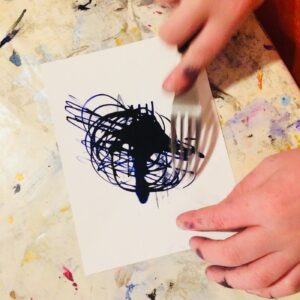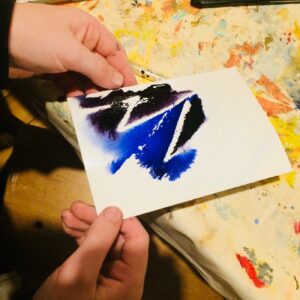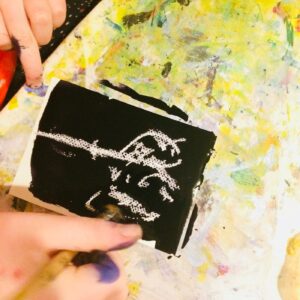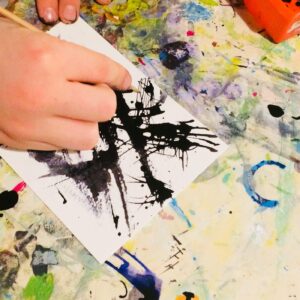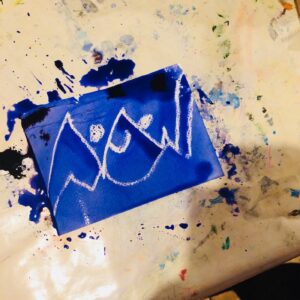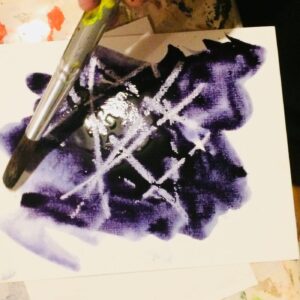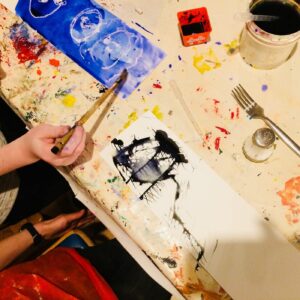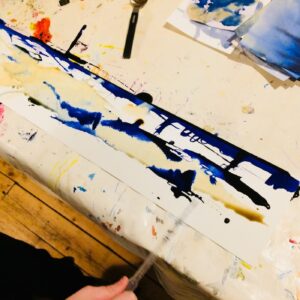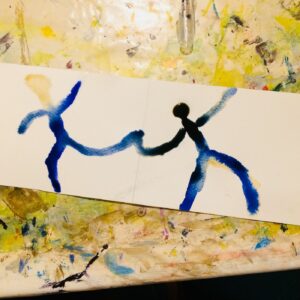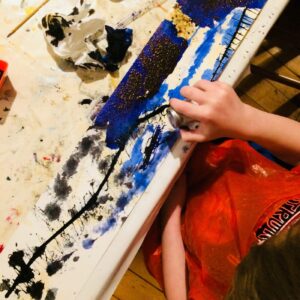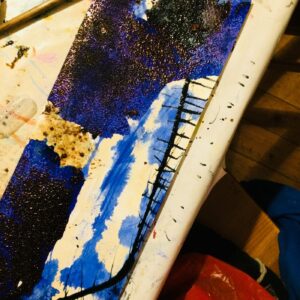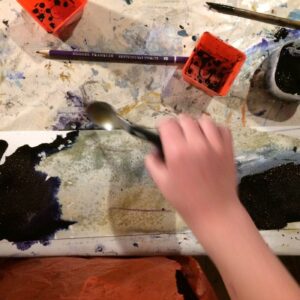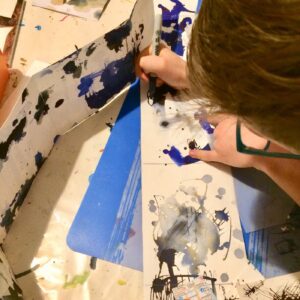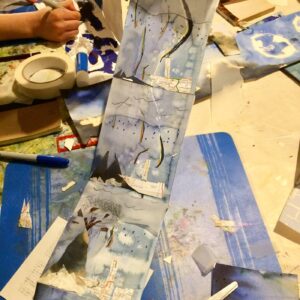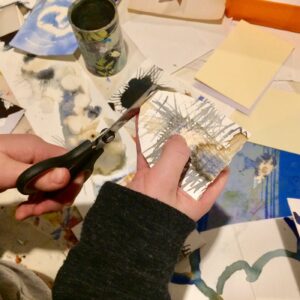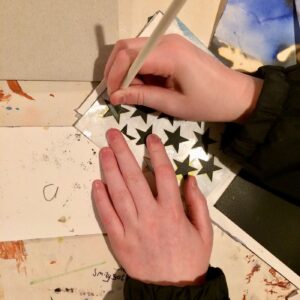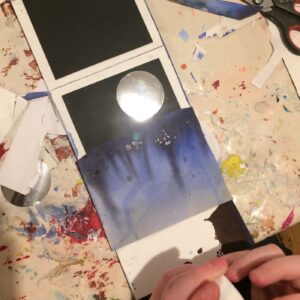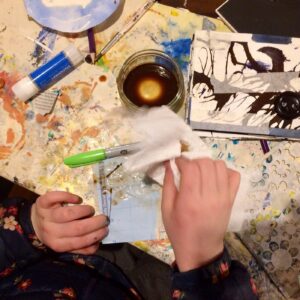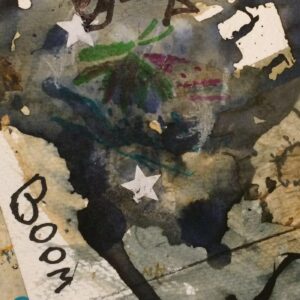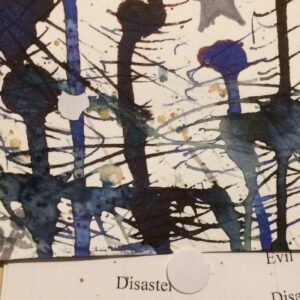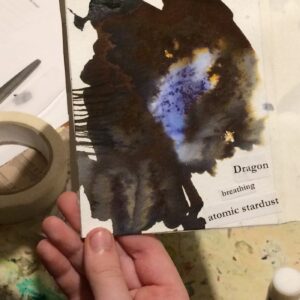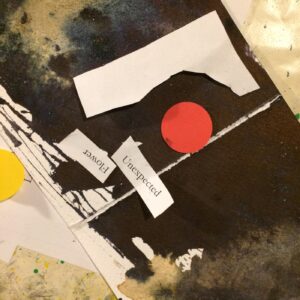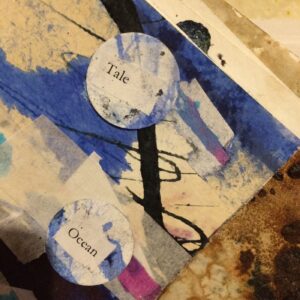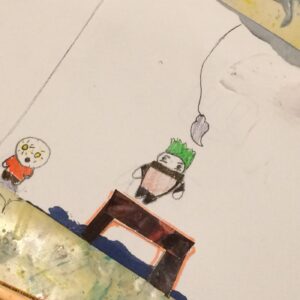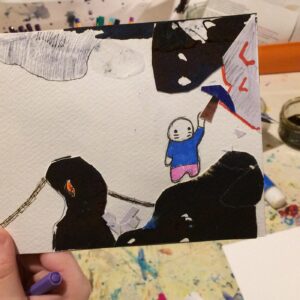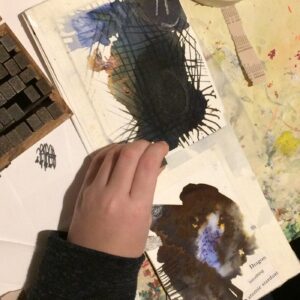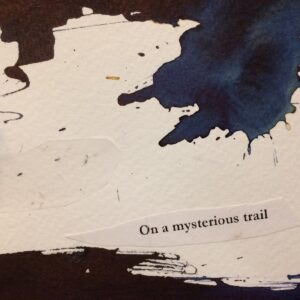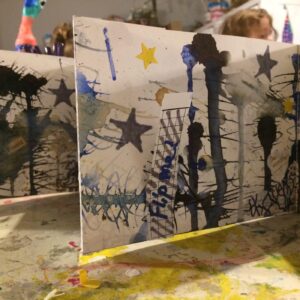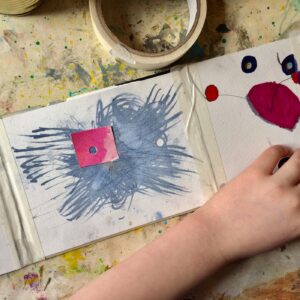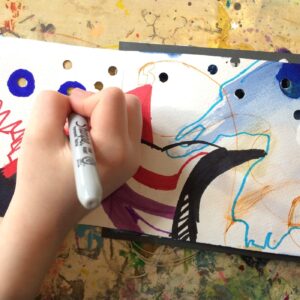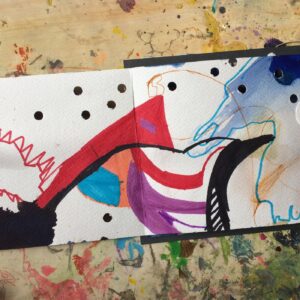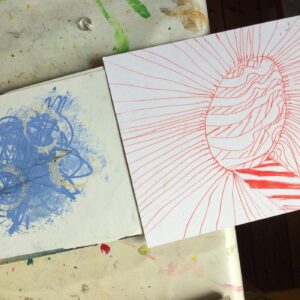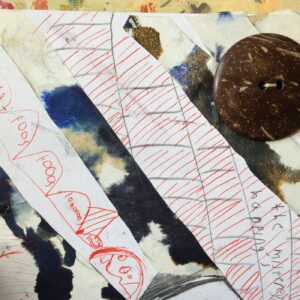Artists’ Books – mark making and imaginative writing.
Week 1
As with all the classes for the Spring workshops, the young creatives gave me lots of ideas for the development of this workshop block. Books and imaginative writing were ideas that emerged from the Tuesday class. This gave me the idea to look back at a previous workshop I had run with two different classes on a Saturday and Wednesday – when we had made wonderful textured/collage paper and used this as a background to illustrate stories. But I wanted to develop this concept further – given that this class has older children I always figure I can set them a bigger challenge. So I decided to indulge my love of books and in particular my love of artists’ books…. it took a while to explain this idea to the class – that books can be the actual art work, just like a painting or a sculpture – rather than just a book about art. Once we had spent a while talking about this, looking at images on the internet as well as some of my own books from my very modest collection of artists’ books, we talked about how we were going to make our books. I briefly talked about some of the different binding techniques which can be used as well as the infinite number of ways artists can make and present their books as a work of art. For this workshop, we are going to be making a simple concertina style book which can either be read as a book or hung on the wall as you would a painting.
As this workshop progresses, the children will have the opportunity to add a narrative to the pages of their books – this will be either extracts from a story or poem they are particularly fond of, or if they have their own imaginative story they have been working on. There will be an opportunity in the workshop to create a short piece of writing. But to start off with, we needed to make our pages.
This process of making the pages – which involved playing with mark making by experimenting with a variety of tools with ink on a variety of different types of paper – will lend itself to the potential narrative of the book, as we looked at the psychological phenomenon of paredolia. Now, while nobody had ever heard of this word before – myself included – we all knew what it was – when you see something, perhaps a face or an object in something else unrelated. Who hasn’t spotted a dragon, a dinosaur or an animal in the clouds?! So the process of making the marks on the page may well create the narrative in the book, as the young creatives use their imaginations to look for images and stories in the marks they make. Some wonderful patterns were made and the children really got into seeking out hidden pictures on their pages. The children will have the opportunity to develop these pages more and work into them with other materials as the workshop progresses.
Week 2
We continued experimenting with mark making with a variety of tools and ink – but this week we used long pieces of watercolour paper which will be folded into the basic concertina shape for the book. The young creatives were encouraged to use techniques which they had particularity enjoyed during week 1, and which had produced marks and patterns that were of interest to them. Images and stories have already started to reveal themselves, which will be developed further at a later workshop.
Week 3
The focus this week was folding the paper into a concertina book and starting to look at each page to ‘find’ a story. Some of the young creatives chose to work further into the marks already made – to develop the visual narrative as well as thinking of ideas about what words to add to their story. The focus of the narrative will continue and develop over the next 2/3 weeks.
Week 4
We started this session revisiting the idea of paredolia that we had talked about while making the marks on the paper. To help find a ‘narrative’ in their books the young creatives were encouraged to spend time ‘re-looking’ at what they had made so far and to brainstorm any ideas and thoughts that came into their head. They were encouraged to wrote down any ideas, and not worry too much about creating sentences, but rather finding interesting words to evoke a mood and describe and setting. These words and the marks made will mesh together to form a narrative in the books. For the rest of the session, they carried on to develop the pages in their books – some chose to draw directly on to the pages, to enhance the paredolia marks they had already made, other used stencils on some of their pages. Some chose to embellish their pages with materials such as tracing paper, graph paper, maps, buttons and paper shapes. They were all encouraged to take their ideas in whatever direction they wanted, but guided with techniques they could try and materials they could use.
Week 5
We used this penultimate session to pull the books together – the young creatives added their words from the previous week – I typed these up for them to add to their stories using a collage technique, while others chose to hand write their words. This was a really busy intensive session – they all seemed to be utterly engrossed with the making – and making great effort to conclude their ‘stories’ with some great words, marks and drawing.
Week 6
This last session was all about adding a simple fastening to the book – using buttons and a linen tie. Then the young creatives were able to complete any missing elements from their books – like adding finishing touches the the books covers, completing their stories and ensuring everything was attached properly.
Everyone worked so hard for this block – these were slightly more challenging workshops and getting to grips with the concept and narrative as well as the technical aspects, was really quite an achievement. Everyone worked through any frustrations they had and produced really beautiful, well thought out and hugely imaginative books. I am so proud of them all – the books are stunning. I am a huge fan of mark making in art work, and how the use of this technique can create really stunning pieces of artwork. And this combined with their amazingly creative minds, their finished books are truly wonderful artworks!
At the moment, there are limited photographs to show off their books – the last session was so busy I didn’t get chance to take many photos. However, once my new camera lens arrives I will take some photographs worthy of the quality of their books.
